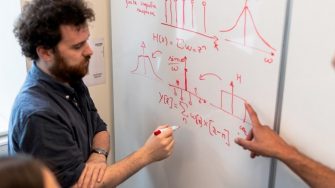
Through advanced simulation methods we aim to understand, design and improve materials used in cutting-edge engineering applications. We achieve this by bridging the length scales from atomic scale (sub-nano) to device-level (macro), using state-of-the-art techniques. This enables a deeper understanding of materials and processes that we aim to improve.
Atomic simulations
With rapid advancement of material fabrication technologies and manufacturing process, new multi-functional materials are being created for wide range of applications. We use a range of advanced quantum-mechanical and classical modelling techniques to aid the development of new materials with the desired mechanical, electrical, chemical or even flammability properties. Atomic scale simulations also provide direct insight into the processes that occur within materials.
We investigate how materials perform under extreme conditions, such as ultra-high temperatures, under radiation bombardment or in harsh corrosion environments. These simulations enable us to design improved materials that will enable future technologies:
- Radiation tolerant materials for fusion reactors and power sources for space
- Ultra-high temperature ceramics for fuel-efficient low-carbon jet engines
- Fire retardant composites to degradation resistant components for long-lived batteries and supercapacitors.
Composites (micro – meso)
By coupling micro and meso-scale modelling, together with stochastic analysis, we can make reliable predictions about the thermomechanical response of composite materials. We can model the dynamic failure of composite components, including that of complex joints and connections. This is key to improving the design confidence of composite materials, which is currently limiting the widespread uptake of composite in aerospace, pressure vessels and other safety-critical applications.
Additive manufacturing (meso – macro)
Our state-of-the-art capabilities are supported and enhanced by a suite of simulations techniques. Finite element analysis provides insight into laser powder bed fusion, including laser-material interaction, melt pool behaviour, defect formation, solidification and heat dissipation. We use computational modelling, validated by experimental observation, to optimise the topology and structure of the components, to produce final parts with improved mechanical and functional properties.
Model development
With increasing computational power available, we are continually pushing the boundaries of the methodologies at all length-scales. Some key advances include:
- Cohesive zone crack propagation models incorporating strain gradients.
- Development of high throughput simulation methods that enable accurate modelling of defects in multicomponent engineering alloys.
- Novel solid deformation models based on discrete elements.
- Novel meshing and model generation strategies for textile, braided, wound and AFP composite structures.
- Full-scale fire scenario modelling by coupling of Computational Fluid Dynamics simulations with pyrolysis kinetics from molecular dynamics.





